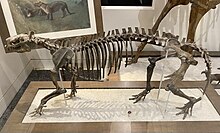Phenacodus
| Phenacodus Temporal range:
| |
|---|---|

| |
| P. primaevus skeleton at American Museum of Natural History | |
| Scientific classification | |
| Domain: | Eukaryota |
| Kingdom: | Animalia |
| Phylum: | Chordata |
| Class: | Mammalia |
| Family: | †Phenacodontidae |
| Subfamily: | †Phenacodontinae |
| Genus: | †Phenacodus Cope, 1873 |
| Species[1] | |
| |
| Synonyms | |
|
Trispondylus Cope, 1884 | |
Phenacodus (Greek: "deception" (phenax), "tooth' (odus)
Description
Phenacodus intermedius reached 10 to 39 kg (22 to 86 lb), while P. trilobatus is estimated at 22 to 87 kg (49 to 192 lb).[3] The typical Phenacodus primaevus was a relatively small ungulate about 1.5 m (4 ft 11 in) long and weighed up to 56 kg (123 lb), of slight build, with straight limbs each terminating in five complete toes, and walking in the
In habits, the animal was cursorial and herbivorous, or possibly carnivorous. In the early Paleocene of North America, the place of the above species was taken by Tetraclaenodon puercensis, an animal only half the size of P. primaevus, with the terminal joints of the limbs intermediate between hoofs and claws, and the first and fifth toes taking their full share in the support of the weight of the body. These two genera may be regarded as forming the earliest stages in the evolution of the horse, coming below Hyracotherium (see Equidae). As ancestors of the artiodactyl section of the Ungulata, we may look to forms more or less closely related to the North American Lower Eocene genus Mioclaenus, typifying the family Mioclaenidae. The species of Mioclaenus were five-toed, bunodont Condylarthra, with a decided approximation to the perissodactyl type in the structure of the feet. A second type of Condylarthra from the North American Lower Eocene is represented by the family Meniscotheriidae, including the genus Meniscotherium.
A 2014 cladistic analysis places both Phenacodus and Meniscotherium within stem perissodactyls.[6]
Teeth and jaws probably referable to the Condylarthra have been obtained in European early Tertiary formations. All Ungulata probably originated from Condylarthra.
Phylogeny
Cladogram after Gelfo and Sigé, 2011:[7]
Gallery
-
Restoration by Charles R. Knight
-
Skeleton of Phenacodus primaevus
-
Restoration by Heinrich Harder
-
Comparison of P. primaevus with a human
References
- ^ Thewissen, J.G.M. (1990). "Evolution of Paleocene and Eocene Phenacodontidae". University of Michigan Papers on Paleontology. 29: 1–107.
- ^ "Glossary. American Museum of Natural History". Archived from the original on 20 November 2021.
- PMID 19828961.
- ISBN 9780191545177. Retrieved 3 March 2024.
- ISBN 9780123708786. Archived(PDF) from the original on 2022-11-20.
- PMID 25295875.
- .
- This article incorporates text from a publication now in the public domain: Chisholm, Hugh, ed. (1911). "Phenacodus". Encyclopædia Britannica. Vol. 21 (11th ed.). Cambridge University Press. p. 364.




